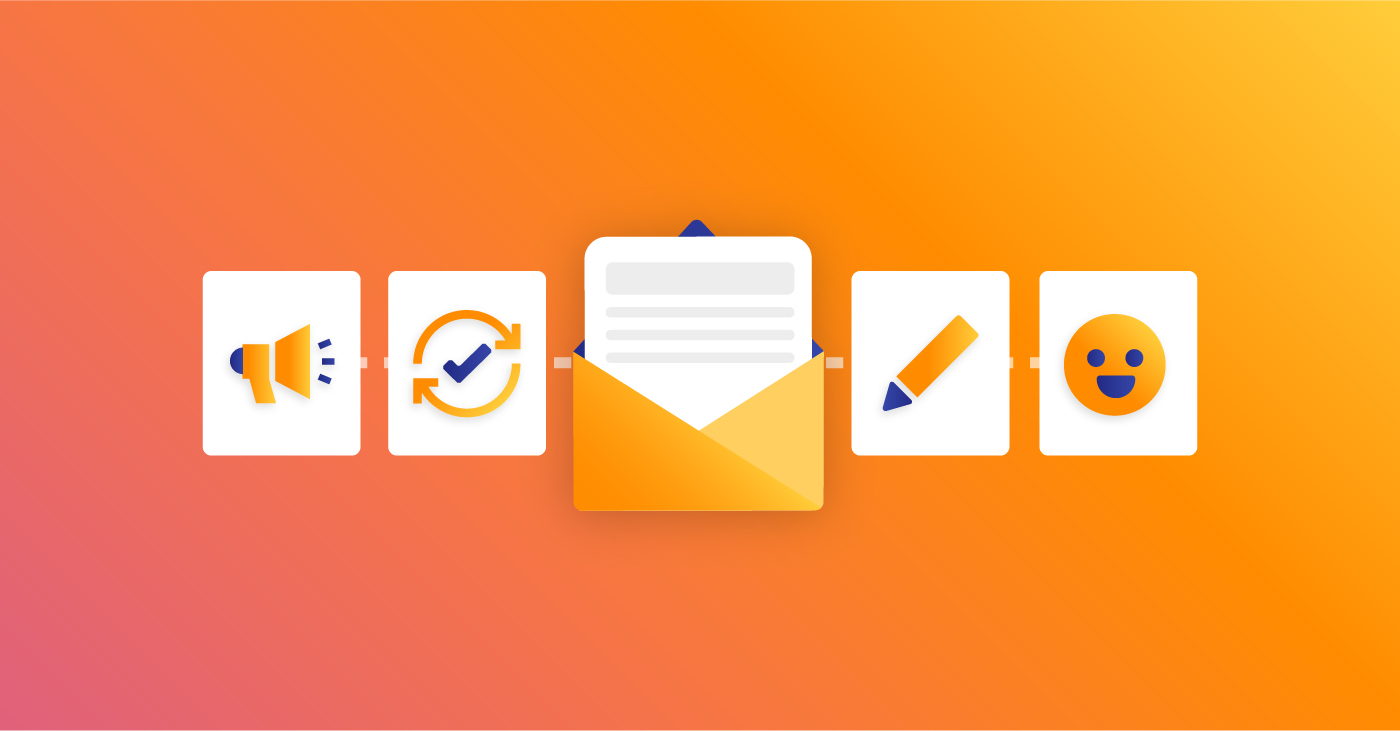
Need details on how to send a successful email marketing campaign? Here’s everything you need to know.
The key to any successful email marketing campaign is knowing your target audience and continually optimizing your campaigns to build on your success. Everything from targeting the audience to personalizing emails plays a role in getting those coveted opens, clicks, and purchases. If you’re less than satisfied with your email marketing campaign results, try one or all of the following tips to give your email marketing campaign performance a boost.
Basic Email Marketing Campaign Optimization Tips
If you’re getting started with email marketing, here are the fundamental things you must do to set your campaigns on a path toward success.
1. Know Your Audience
If your message is for everybody, it’s for nobody. Generic emails don’t cut it anymore: today’s customers expect the brands they interact with to send personalized communications and highly relevant offers. However, to send personalized emails, you have to understand your audience beyond their demographics.
- What are their interests, needs, and preferences?
- When and how do they prefer to receive their emails?
- What unique qualities set them apart from the general public?
- What’s in it for the subscriber?
You won’t have the answers to these questions right away. However, with time and after several email campaigns, you’ll have enough data and insights to deeply understand each cohort of subscribers so that you can start segmenting them effectively.
2. Segmenting Your List
Whether you have 10, 100, or 1,000 subscribers, they probably don’t share the exact same needs, preferences, and interests. That means a batch-and-blast campaign would yield minimal benefits if any.
When it comes to failed email marketing campaigns, there’s a commonality that many share: the campaign didn’t work because the sender sent the same message to everyone, regardless of their needs. For example, the person who wants to hear about offers on computer software gets a generic email featuring an update about new hardware.
For your campaigns to be highly effective, you have to segment your list. Segmented campaigns achieve 50% higher click-through rates and higher open rates than non-targeted campaigns. You can segment your list based on various factors, including:
- Demographics
- Requested email frequency
- Content interest
- Location
- Purchase history
- Email open time
3. Personalize Your Emails
Segmentation drives personalization. In other words, it lets you send emails that resonate with each segmented list. Keep in mind that segmentation goes beyond calling customers by name.
Be sure to gather more granular details about each customer segment, and send them personalized offers, discounts, and more. Moreover, use language that will make your message resonate with the subscribers. Sending personalized emails makes it easier to build trust with your customer base because they’re able to see how you can anticipate their needs.
4. Check For Grammar and Errors
It goes without saying that your messages to your subscribers should be free of any grammar and spelling errors. You should also take care to edit the message to embody the tone and style that your brand is known for. Above all, remember that warm, persuasive, and engaging emails are most likely to hold the attention of your customers.
5. Keep Your Layout Simple
Don’t design your emails with too many graphics. Doing so could overwhelm your subscribers and land your emails in the spam folder. Instead, keep your layout simple so as to not take away from the main message the email is meant to convey. With a simple layout that utilizes whitespace appropriately, your key message will be succinct, clearly communicated, and easy to understand.
6. Don’t Overload on Copy
If you have lots to say, it’s easy to let your emails run on for many paragraphs, but be wary that your customers likely have limited time to read their emails. Be as concise as you can, and if there’s more that you want to say, you can include a link to a landing page where your subscribers can find out more.
You can say a lot without bogging down your emails with tons of copy. To make your email copy dazzle, get as creative as possible, but keep each paragraph to two-three sentences maximum.
7. Include a Call-to-Action
You want your email recipients to do more than just read the email – you want them to take action. This is where a clear call-to-action (CTA) is important. What is it you want your email recipients to do? Some CTAs could be:
- Filling out a website form
- Clicking on a link to read more
- Visiting your website or product page to buy something
- Registering for a webinar
- Downloading a whitepaper
8. Create a Compelling Subject Line
You’ll need a strong email subject line to get the attention of your customers, bring them in, and avoid your email being deleted (without even being read). Choose subject lines that get the reader interested, but make sure that the email delivers on what the subject line promises. You don’t want to be misleading, as that will irritate your subscribers (and possibly motivate them to unsubscribe from your emails).
9. Use Email Automation
If you’re just getting started with your business and your marketing campaigns, you probably have to juggle multiple tasks to keep your small business sailing along. If you do manage your email campaigns manually, not only will you be left with no time for other tasks, but you’re leaving the door wide open for human error and missed opportunities.
However, if you look into using email marketing software, you can automate your email marketing, allowing you to do more in less time and free up hours in the day to handle other important aspects of running your business.
With email workflows, you don’t have to set a timer and manually send out emails to customers at every buyer stage. A good email automation software solution, such as Benchmark Email, triggers the messages based on the subscriber’s action.
For example, when a subscriber signs up for your email marketing, your automation tool can be triggered to send that new subscriber a welcome email. If a customer buys your product, there can be a trigger set up to deploy an automated series showing the new customer how to use the product features. You can also schedule milestone emails, such as automated birthday messages, for an added touch of customer support and appreciation.
Advanced Email Marketing Campaign Optimization Tips
Once you have a handle on the basics, like subject line, audience, and CTA, you can start adjusting more components of your email marketing to get an additional lift in engagement and ROI.
Let’s take a look at some of the more complex email marketing tips for you to start implementing once you’re ready.
1. A/B Testing
As a savvy email marketer, you should continuously try new ideas and email strategies to find one that takes you closer to your goals. But don’t just pick an idea (such as a new subject line) and use it in your campaigns blindly. Instead, you can check whether the new concept is stronger than your existing strategy, using A/B testing or split testing.
A/B testing allows you to send emails with one variation of the subject line to a group of your subscribers and a different variation to another group. Once the campaign is complete, you can use your base metrics, such as open rates, to determine which subject line garnered the best results.
Beyond testing subject lines, A/B testing lets you tinker with different email elements, including:
- Use of emojis in a headline
- Headline copy
- Graphic design and imagery
- Call-to-action (CTA) button
- Preview text
- Email copy
When A/B tests your email elements, single out one element at a time for testing and leave the other unchanged. Otherwise, your A/B test results could be hard to decipher. Make sure that you use a large enough sample size for conclusive results.
2. Optimizing Send Times and Days
By now, you have a deeper understanding of your target audience. Perhaps you know details such as their email reading habits, preferred email client, and their location. Using this data and other information, you can figure out the most opportune time to send out your email campaign.
Find out not just the best day but also the time of the day when subscribers tend to open your email. Are they more likely to open and click through emails that you send on Monday mornings or Friday afternoons? By studying your email marketing analytics, you can gather this data and use it to inform future campaigns.
3. Minding the Frequency
The next thing you need to consider is email frequency. Even though email is one of the most effective communication channels, ramping up the email frequency doesn’t necessarily yield better results. Most of the time, sending too many emails to your subscribers could cause high unsubscribe rates.
Statistics show that 69% of users unsubscribe to email lists due to too many emails. The question you should answer is how many emails per day, week or month are ‘too many? To determine what will work for your business, start by sending emails once a week and slowly ramp up the frequency to see how your audience responds. With time, you’ll find an email cadence that improves open rates while lessening unsubscribe rates.
4. Broaden your Focus
Email marketing has tremendous potential and can help you to grow your business, but to tap into the full potential of your email marketing campaigns, you’ll need to think about every stage of the sales funnel.
Let’s say you own an eCommerce store. In an average week, you should focus on new lead generation, nurture existing leads, contact customers with abandoned carts, send welcome emails to your newest clients, and run your usual post-purchase campaigns. Tailor each email campaign carefully to match the stage that the prospect or customer is at in their buying journey in order to get more from your email marketing campaigns.
5. Be Continuously Creative with Design and Formats
Email design cuts across things such as subject line, format, branding, email text, imagery, and CTA. One mistake that some email marketers (particularly those that are just getting started) often make is becoming complacent with email design and format.
With the digital world continuously evolving, so are the needs and preferences of your subscribers. If you want to stay relevant in your customers’ inboxes, you will have to keep your email design fresh with visually appealing campaigns. Remember to keep an eye on other marketing email examples, including those that other players in your industry are running.
6. Stay On Top Of Current Trends
To be successful in email marketing, you have to be flexible when it comes to making room for new developments and trends. Google cookie cutting is one example of an emerging issue that impacts email marketing, and you may already know how the Apple Mail Privacy Protection (MPP) has affected marketers’ abilities to accurately track email metrics, particularly open rates.
With many things outside of your control, you need to remain agile. For example, in the case of the MPP, you can shift focus to look at metrics beyond open rates. Focus on other key performance indicators (KPIs) to guide your strategies and make sure that you can keep tracking meaningful data from your email marketing campaigns.
In a space as dynamic as email marketing taking an email marketing guide, connecting with other people in your niche, or keeping yourself updated by reading the right blogs are all good ways of staying ahead of the pack.
Whether you’re a seasoned email marketing pro or you’re just getting started, Benchmark Email can help you to engage subscribers, nurture leads, and track results. Want to find out more about how we can make your job easier? Sign up for a free account and see for yourself.



